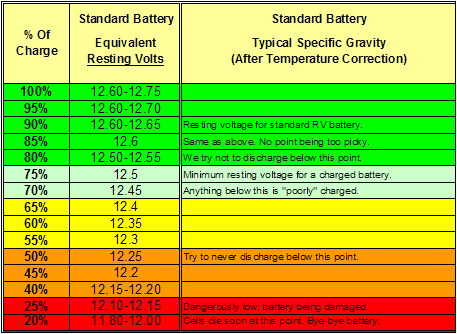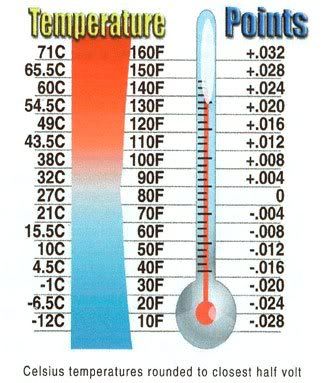Page 1 of 2
Ever wondered how charged your battery actually is ???
Posted: 23 Jan 2012, 18:35
by jamesc76
Found this and thought it might be of some help to people on here, after all a 12v battery at 12v is actually only 35% charged ( at 25degc.)

Re: Ever wondered how charged your battery actually is ???
Posted: 23 Jan 2012, 18:51
by 72BUG
Cheers James.
I always wondered how it worked.
Re: Ever wondered how charged your battery actually is ???
Posted: 23 Jan 2012, 18:59
by jamesc76
72BUG wrote:Cheers James.
I always wondered how it worked.

Your welcome, thought I should finally put it up as a lot of people get the wrong idea with battery charge rates!
Re: Ever wondered how charged your battery actually is ???
Posted: 23 Jan 2012, 19:03
by BOXY
And after leaving my interior lights on for a couple of days, 12v is just enough to turn the engine over half a dozen times, but not enough to start a van


Re: Ever wondered how charged your battery actually is ???
Posted: 23 Jan 2012, 20:13
by California Dreamin
A couple more.....same thing different way of showing it.

Correction chart...depending on temperature.

Charge time and rate against capacity and state of charge..NOTE* CCA (cold cranking amps..the other important figure on your battery after amp hour rating)

Martin
Re: Ever wondered how charged your battery actually is ???
Posted: 23 Jan 2012, 20:38
by kevtherev
Thanks james.. carry that graph on down and the battery is officially dead and buried at 11 v
Re: Ever wondered how charged your battery actually is ???
Posted: 23 Jan 2012, 21:14
by AdrianC
kevtherev wrote:Thanks james.. carry that graph on down and the battery is officially dead and buried at 11 v
Our "leisure" (normal starter)
seems to have survived being down to about 6v before we changed the charger.
Re: Ever wondered how charged your battery actually is ???
Posted: 23 Jan 2012, 21:50
by trentjim
so if the battery is fully charged at 12.8v why does a split charge unit switch at 13.3v (alternator voltage without charging load?)
Re: Ever wondered how charged your battery actually is ???
Posted: 23 Jan 2012, 22:13
by jamesc76
depends on what split charge unit you have, plus there would be a load on the battery whilst running ( stereo lights wipers etc etc ) so the battery has to be higher.
12.8 is at rest is no load
Re: Ever wondered how charged your battery actually is ???
Posted: 23 Jan 2012, 22:51
by trentjim
alright James,
yep, and apply a load and the battery voltage will drop - still doesn't explain the 13.6v that a split charge unit switches at, and where that figure comes from is important if i want to feed solar panels into the same split load system.
Im guessing its something to do with the way the alternator regulates itself based on load - with minimal load something makes me think the voltage is regulated down, the split load circuity detects this & assumes the battery is fully charged. I'll google it eventually. my brain wont let me leave puzzles like that unresolved - it seems counterintuitive that alternator voltage would rise as load is increased... and presumably the "ideal" switching voltage will vary for different alternator/ electrical demand/ battery setups?
Re: Ever wondered how charged your battery actually is ???
Posted: 23 Jan 2012, 23:07
by jamesc76
Well I have a 48watt solar panel on my roof as well as all the split charge and its fine!
Re: Ever wondered how charged your battery actually is ???
Posted: 23 Jan 2012, 23:29
by California Dreamin
The split charge relay isn't smart (despite the fact that some take that name) they just switch and connect the starter battery to leisure battery when the engine is running and the ignition light goes out, simple as!
The switch voltage (on so called smart relays) is set just above battery standing voltage but below regulator voltage.....the actual regulated charge voltage (pressure) changes very little whilst charging, it is the current
AMPS as in (quantity of power) that changes, dependant on the state of the battery charge or if consumers are using power.
The regulation of that current is controlled by the regulator, it does this by varying power to the rotor via the slip rings ( this alters the rotors degree of magnetism..how weak or powerful a magnet the rotor becomes)
The rotor is an 'electro magnet' that spins in the middle of the stator
If the rotor recieves little power then it becomes a mild magnet resulting in the stator producing only a small amount of current from it's 3 sets of windings.
If the rotor recieves more power it becomes a powerful magnet, this strong magnet spinning inside the stator produces a high current output.
The regulated voltage remains fairly static throughout but the current output changes infinately (up to the alternators rated output) depending on the control of magnetism within the rotor.
It gets even more complicated in that alternators produce alternating current from their 3 sets of stator windings (which are set at 120 degrees in the alternators casing)...this type of current changes from positive to negative as the poles of the rotor magnets spin through the 3 winding sets, the poles orientation changing very quickly as they rotate.
AC voltage is pretty useless in motor vehicle applications and this 'AC' current has to be changed into something that can be used to charge a car battery.
For this job a number of diodes are installed at each winding end (diodes act as one way electrical valves, allowing current to flow in one direction but not the other) by installing these in a particular way the current is only allowed to move in one direction, this is called 'RECTIFYING' and so changing the alternating current (push/pull) into direct current (DC, pushing in one direction) the type of current that will charge a vehicle battery.
I hope I haven't lost you.....

Martin
Re: Ever wondered how charged your battery actually is ???
Posted: 23 Jan 2012, 23:50
by California Dreamin
The voltage at which the regulator charges at is important...our old Bosch alternators were fitted with regulators set at 13.9 - 14.2 volts. If you hadn't already realized, charging occurs because of 'potential difference' or in laymans terms....the difference between standing battery voltage (12.7 volts for a fully charged battery) and the alternators 13.9 - 14.2 volts). Think of it this way, two people pushing a bicycle, one at the front pushing on the front forks and applying 100KG of pressure, the other person pushing the rear of the bike but applying 150KG of pressure. Which way will the bike go? FOWARDS OF COURSE! there you have it....Potential Difference. REMEMBER VOLTAGE IS PRESSURE!.
Now take this on one step further......Regulated voltage still 13.9 - 14.2 but now the battery is only 20% charged so reading just 11.9 volts approx...the PD (potential difference) has now increased from about 1.3 volts to over 2 volts....WHAT DO VOLTS EQUAL? PRESSURE! so the current flow is now pushing harder towards the battery.
NOTE* if you buy a replacement regulator brush pack the likelyhood is that the pre-set 'regulated' voltage will have risen to something between 14.2 - 14.5 volts to cope with the charge requirements of NEWER Silver Calcium batteries (older batteries were lead/acid). The original regulator setup is unlikely to fully charge one of these new battery types. Don't say I didn't tell you.
Martin
Re: Ever wondered how charged your battery actually is ???
Posted: 24 Jan 2012, 05:35
by Mickyfin
Great info, and answers the questions I have been pondering about., With temperatures now well into the -20's, I'm finding it more difficult to start my Syncro due to not having a night oil heater.
Re: Ever wondered how charged your battery actually is ???
Posted: 24 Jan 2012, 19:16
by trentjim
Thanks Martin,
lots of things I half knew there, all now clear in my head.
Its also changed my understanding of a split charge system - I thought it only sent current to the leisure battery once the starter battery was fully charged...whereas from your explanation it sends current to both batteries, irrespective of the charge state of the starter battery, as long as the alternator is turning.
makes sense and explains where the 13.? comes from....
cheers,
James





